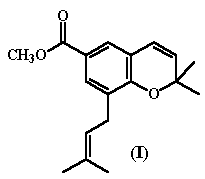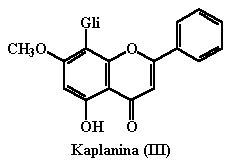Ph.D. Thesis
Abstract
Piper
aduncum L., P. amplum Kunth, P. gaudichaudianum Kunth
and P. lhotzkyanum Kunt were submitted separetely to successive
extraction with hexane, dichloromethane, ethyl acetate and methanol or
to extraction with methanol and subsequently partition of the obtained
methanolic extract with organic volatile solvents. These extracts and fractions
were submitted to chromatographic and other purification techniques yielding
pure compounds and mixtures that were identified by spectrometric analysis.
The hexane extract from stems of P. aduncum collected in Carmo/
RJ, afforded a mixture of hydrocarbons (C16-C33), a mixture of monoterpenes,
sesquiterpenes, eupatoriochromene and the new chromene (I) Methyl
2,2-dimethyl-8-(3-methyl-2-butenyl)-2H-chromene-6-carboxylate, along with
5-Hydroxy-7-methoxyflavone and a mixture of Sitosterol and Stigmasterol.
The hexane extract from flowers of P. aduncum collected in Volta
Redonda/ RJ, yielded 2-Hydroxy-4,6-dimethoxy-dihydrochalcone and 2,6-Dihydroxy-4methoxydihydrochalcone.
The dichloromethane extract afforded 2,6-Dihydroxydihydrochalcone, 2,4-Dihydroxy-4,6-dimethoxydihydrochalcone
and 2-4-Dihydroxy-4,6-3-trimethoxydihydrochalcone.
Leaves of P. amplum furnished a mixture of Sitosterol and Stigmasterol
from the hexane extract and Vitexin-2-O-rhamnoside from the butanolic
fraction of the methanolic extract.
The leaves hexane extract from P. gaudichaudianum afforded a mixture
of Sitosterol and Stigmasterol and a mixture of 2,6-Dimethoxy-4-dihydroxychalcone
and 2,6-Dimethoxy-4-dihydroxydihydrochalcone.
From the crude hexane extract of P. lhotzkyanum leaves it were isolated
a mixture of hydrocarbons (C16-C31); a mixture of seven sesquiterpenes
and E-Fitol; the E and Z isomers of 3-(3-7-Dimethyl-1-oxo)-2,6-octadienyl-4-hydroxybenzoic
acid; and a new chromene (Lhotzchromene, II). The dichloromethane
fraction of the methanolic extract from P. lhotzkyanum leaves afforded
a mixture of four C6-C3 derivatives; Methyl 4-methoxydihydroferulate; 5-Hydroxy-7-methoxydihydroflavone;
and a new C-glycosylflavone (Kaplanin, III). Vitexin was identified
in the butanolic fraction of the methanolic extract.
Piper solmsinaum, P. lhotzkyanum, Peperomia alata
Ruiz et. Pavon, P. obtusifolia A. Dietrich, P. pellucida
(L.) H.B.K. and P. scandens Ruiz et. Pavon, were analised in relation
to their volatile composition.
The essential oil from P. lhotzkynaum leaves showed the presence
of monoterpenes and sesquiterpenes. The essencial oil from P. solmsinaum
revealed monoterpenes, sesquiterpenes and arylpropanoids. The main constituents
of this oil (Sarisan and ?3-Cerene) were isolated through column chromatography
on silica gel.
The essential oil from the analised Peperomia species showed
a rich and diversified sesquiterpene fraction. Analysis of the essential
oil from P. scandens revealed high concentration of one sesquiterpene
(~70%). Column chromatography of this essential oil lead to the isolation
of a sesquiterpene and a mixture of Dillapiol and Apiol.
Piper gaudichaudianum
extracts, fractions and the isolated mixture Sitosterol and Stigmasterol,
were submitted in vitro to analgesic and antinflammatory tests. Sitosterol
and Stigmasterol showed antinflammatory and peripheral analgesic activities.
Leaves essential oil
from P. solmsianum and its major constituent (Sarisan) were tested
on mice behaviour. Exciting and depressant effect were verified with whole
essential oil or Sarisan administration.





